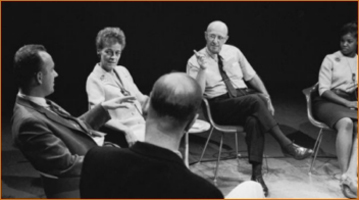4. Comparison with Encounter Group Work
We have already mentioned how Adi Da's "Teaching Work" with devotees — the modality He used that focused on teaching through incident rather than verbal instruction — has many similarities with the exercises that can occur in encounter groups. We'll now explore the similarities (and differences) in a little more detail.
Encounter groups (also known as T-groups — "T" for "Training"; sensitivity-training groups; or human relations training groups) were first developed in 1946 by Kurt Lewin, Kenneth Benne, Leland Branford, and Ronald Lippitt, working for the U.S. Navy's Office of Naval Research and the National Education Association. In the 1950's, T-group sessions focused on sociopolitical issues of the time such as the meaning of democracy, social values, better ethnic relations, and nuclear power. (For example, an early encounter group, "the Connecticut Event", was aimed at fostering better relations between African-Americans and Jews in Bridgeport, Connecticut.[4]) In the 1960's and 1970's, the focus of encounter groups shifted to personal growth.[3] Renowned American psychologist Carl Rogers' advocacy of encounter groups ("the most significant social invention of the century") [1] helped bring them into prominence in psychotherapeutic circles. Organizations such as EST and Lifespring then took the "encounter group" concept into the mainstream, implementing and franchising it in a way that made it available to large numbers of people in the 1970's. In 1994, it was estimated that at least 1.3 million Americans had participated in LGAT (Large Group Awareness Training) sessions of one kind or another. An encounter group represents several significant departures from talk therapy: a shift from purely talk to incidents (experiential encounters with other participants); a shift from a one-person, "therapist-patient" relationship to a kind of therapy where encounters with others (usually guided by a "group leader"), even many people, played a significant role; a shift to a less structured form of therapy; and a shift in focus from neurotic "patients" hoping to become "normal", to "normal" adults who were looking to grow further ("therapy for normals"). To help make this discussion concrete, here's an example. One such encounter group in which I participated (back in 1980, in Lifespring) had an exercise known as the "hot seat". A person would be selected to sit in the "hot seat"; other people in the group would come up and speak, without any self-censoring, whatever came to mind as they looked at the person; and the person in the "hot seat" was required to either stay silent or say "thank you". I remember getting a profound lesson while sitting in that "hot seat", when I was in my early 20's: all the things I was trying to get people to not think about me, turned out to be what most of them were thinking anyway! The net result: I relaxed. (As Adi Da humorously puts it: "Relax. Nothing is under control.") From that point on in my life, I let go of a lot of my concern about my "self-image", since I got the point that all that concern was pretty ineffective anyway. The intention of such exercises was similar to Adi Da's intent: to reflect people to themselves, and to free up energy and attention, as participants understood and transcended specific limiting patterns in themselves. But there were some critical differences as well:
It should be noted that, like crazy-wise Gurus, encounter groups also often got a bad rap, and were also often labelled "cults", etc. The key thing that bothered the critics was the participant's loss of control (unexpected incidents occurred all the time), and the possibility for abuse in such a situation. But of course the guarantee that one will never lose control in such a situation is tantamount to the assurance that one will never be "touched" or "penetrated" by what one is "participating" in — i.e., the guarantee that one will remain egoically immune, which defeats the very purpose of the exercise. (Talk therapy is generally constrained in just this way, but that's precisely one of the reasons why one can remain unchanged even after decades of talk therapy!) If, on the other hand, one chooses an encounter group or one's Spiritual Master with discrimination, and allows oneself to be fully penetrated in such incidents, the potential for growth is immensely greater than a circumstance that is endlessly self-protected.
|
| Quotations
from and/or photographs of Avatar Adi Da Samraj used by permission of the copyright
owner: © Copyrighted materials used with the permission of The Avataric Samrajya of Adidam Pty Ltd, as trustee for The Avataric Samrajya of Adidam. All rights reserved. None of these materials may be disseminated or otherwise used for any non-personal purpose without the prior agreement of the copyright owner. ADIDAM is a trademark of The Avataric Samrajya of Adidam Pty Ltd, as Trustee for the Avataric Samrajya of Adidam. Technical problems with our site? Let our webmaster know. |
